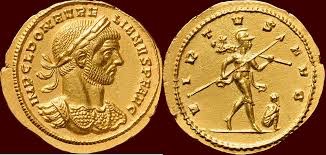The Lava hoard is a Roman treasure of coins and gold plate that was discovered underwater in the small Gulf of Lava, southern Corsica, France, probably in 1958. Also known as the Corsica hoard, It's one of world's most important archaeological finds.
 | The “Corsica Hoard” was first discovered in the late 1950s by two urchin divers. Under French law, all underwater archaeological finds belong to the state. The treasure was dispersed into many private and public collections. 41 aurei and large gold medallions were sold to collectors. In 1986 it was revealed hundreds of high-grade Roman gold coins dating from 262 to 272 CE had been found. | |

A extremely rare gold medallion or 'multiple solidus' of Claudius Gothicus. 268 AD. Equivalent to 8 regular gold solidi. 38.83 grams. | 450 pieces remain in public hands. Its thought the hoard contained at least 1,400 coins, comprised of coins from Gallienus, Claudius II, Quintillus, and Aurelianus. Archeologists date the wreck to either late 272 or early 273 CE. The gold coins found cover the period from the AD 262 Decennalia of Gallienus to the reign of Aurelian in AD 272. |




No comments:
Post a Comment